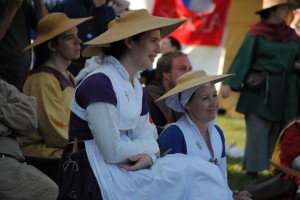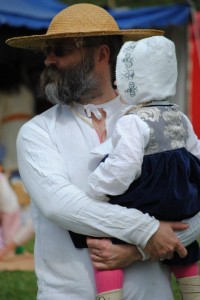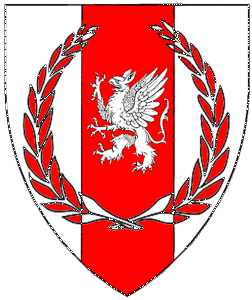The SCA is well known for our medieval costumes, but how do you get started? For your first one or two events, if you don’t have medieval-style clothes of your own, these can be borrowed from your local Chandler (equipment loans officer. Ours can be contacted at chandler.polit@gmail.com). Please contact them well before the event you are planning to attend to arrange this as they may not have appropriate gear with them at the event. This is only a temporary measure and you are expected to get your own gear as soon as possible. When you do start getting your first set of garb together keep the following hints in mind.
Options From Your Wardrobe
 Women’s clothing – Try searching op-shops for long dresses that can be modified easily. Look for dresses, skirts, nightgowns, or extra-large t-shirts and belt them at the waist for the start of a medieval look. (Remember to wear solid colours if you can.) If you can only find dresses or ‘tunics’ with short sleeves, you can wear a long-sleeved shirt underneath to cover your arms.Cloaks can be made fairly easily and they hide a multitude of sins. If it is winter and cold, try getting something a bit too big so that you can wear warm mundane clothes underneath. Modern looking slippers, boots and shoes can often be hidden under long skirts.
Women’s clothing – Try searching op-shops for long dresses that can be modified easily. Look for dresses, skirts, nightgowns, or extra-large t-shirts and belt them at the waist for the start of a medieval look. (Remember to wear solid colours if you can.) If you can only find dresses or ‘tunics’ with short sleeves, you can wear a long-sleeved shirt underneath to cover your arms.Cloaks can be made fairly easily and they hide a multitude of sins. If it is winter and cold, try getting something a bit too big so that you can wear warm mundane clothes underneath. Modern looking slippers, boots and shoes can often be hidden under long skirts.- Men’s clothing – Plain trousers, karate pants, tracksuit pants all look OK under a short tunic. leggings are also a good looking option and don’t be afraid to look in the ladies section. Plain boots that look medieval-ish are easy to find. Ugh boots have been around for over 1000 years. A tunic looks like a large plain T-shirt and a bit of braid around the collar and sleeves can disguise the modern style of dress. A Surcoat (a big, rectangular, strip of cloth with a hole for the head) can disguise a more mundane item of clothing underneath. Long sleeved skivvies can be worn under tunics and Surcoat for warmth in winter. Get a good plain colour belt to wear around your tunic.
 Simple Sewing
Simple Sewing
The easiest way to hide modern clothes is a ‘tabard’: a long rectangle of fabric with a hole in the middle for your head. You’ll find instructions here
If you want to have a go at making a medieval garment, you can try your hand at a ‘t-tunic’ instead – this is the generic item on which the costumes for a wide range of times and places are based, and just about everyone in the SCA owns one. A very simple method is available here. For a more medieval approach, try this site.
“But I can’t sew… I don’t have a sewing machine … help!” If you can’t sew and have no idea about putting clothing together, ask around as there are people who can help you. Arts and Sciences meetings are a good place to start. Often you can get the difficult bits done for you leaving the easy sewing for you to do. And early period garb is really easy! You don’t need sewing experience to start making garb!
Accessories
Everyone knows accessories make the outfit. So what do accessories should you have?
- A long belt worn over the tunic, with the tail left hanging at the front. Cord can also be used. (Any colour except white is acceptable)
- Plain leather shoes or boots
- Headdresses, hats, and veils were common in our period, but it’s okay not to wear any. They’re a good way to keep the sun and rain off, though, and hoods can help keep you warm
- Wool cloak when it’s cold – the simplest ones are nothing more complicated than a blanket pinned at the shoulder
Things to Avoid in Costuming:-
Anything that is uncomfortable or dangerous. Many ladies realise too late that the long trailing dress that looks so nice can trip you up if you aren’t used to it. Men find the same thing wearing swords. If you are uncomfortable in your clothing then you will not enjoy the event you are attending quite as much.
- BELTS – Don’t wear anything that looks like a white belt. The white belt is reserved for knights.
- JEWELLERY – Don’t wear a plain chain without a pendant hanging off it – these are reserved for knights. Don’t wear spurs for the same reason.
- DON’T wear crowns, tiaras, or coronets. These are reserved for royalty and peers. A good guideline is if it is wider than 2cm, it if has decorations that extend above or below the circlet, if it isn’t plain straight circlet which has no points or jewels then don’t wear it. Plain circlets decorate along the band are OK but avoid anything decorated with stones, jewels, or pearls.
- SWORDS / KNIVES / BLADES – avoid wearing sharp weapons without scabbards – they are dangerous. Make sure all blades are secured in their scabbards – so they can’t fall out. Be very careful wearing a sword – it can stick out behind you and trip others or damage their clothes.
When in doubt ask someone who has been in the SCA much longer than you.
I need help
That’s okay! We know it can be intimidating to figure out something to wear, and we’re always happy to help out. We have a store of clothing in all shapes and sizes that we lend out to newcomers, so if you want to have a look for something you can wear to an upcoming event, feel free to get in touch with our Chandler (equipment loans officer) at chandler.polit@gmail.com.
Resources
- Costuming Through the Centuries – instructions for a range of garments in our period
- Medieval Clothing Pages – includes a number of articles on making medieval accessories
- The Renaissance Tailor – detailed information about 16th and 17th century clothing (note that the beginning of the 17th century is our cut-off date)
- Briana’s Clothing Page – a large collection of links to other costuming articles and sites
Hair & Headdress
- Chaperons & How to Make Them – The Costumer’s Manifesto – search “Chaperons”
- How To Make A Quick Hat/Helm – Quick Leather Hat
- Italian Renaissance Hair Taping – Introduction by Margo Farnsworth:
- Medieval Clothing Pages: Hat & Hair articles by Cynthia Virtue
- The Auld Garb Monger’s Free Sewing Projects – free hat projects
- Stefan’s Florilegium – Medieval-Hair-lnks
- Tudor Gable Headdress Illustrated: Step by Step Directions – Hope Hall For The Humanities
- Upbraid Yourself and Others: The Basics of Braiding – A Workshop & Notes by Cynthia Virtue
- Viking Answer Lady on Hair: Viking Age Hairstyles, Haircare, and Personal Grooming
Shoes
- Footware of the middle ages – I. Marc Carlson
- A Shoe from Parliament Street – York Construction notes
Roman, Greek, & Byzantine
- Roman Costume – citizen, matron, curule magistrate, emperor, general, workman, slave
Norse & Viking
- http://www.cs.vassar.edu/~capriest/vikresource.html
- http://www.norseamerica.com
- http://www.historiska.se
Elizabethan & Tudor
Renaissance & Italian
- The Renaissance Tailor: Recreating 16th & 17th Century Clothing – research, demonstrations etc
- http://www.modaruniversity.org/briana/Briana3.htm
- http://www.uvm.edu/~hag/sca/15th/
- http://www.angelfire.com/zine/kiarapanther/garb/italian.html
- Hair Taping
- http://www.florentine-persona.com/
- Realm of Venus – excellent resource of images

